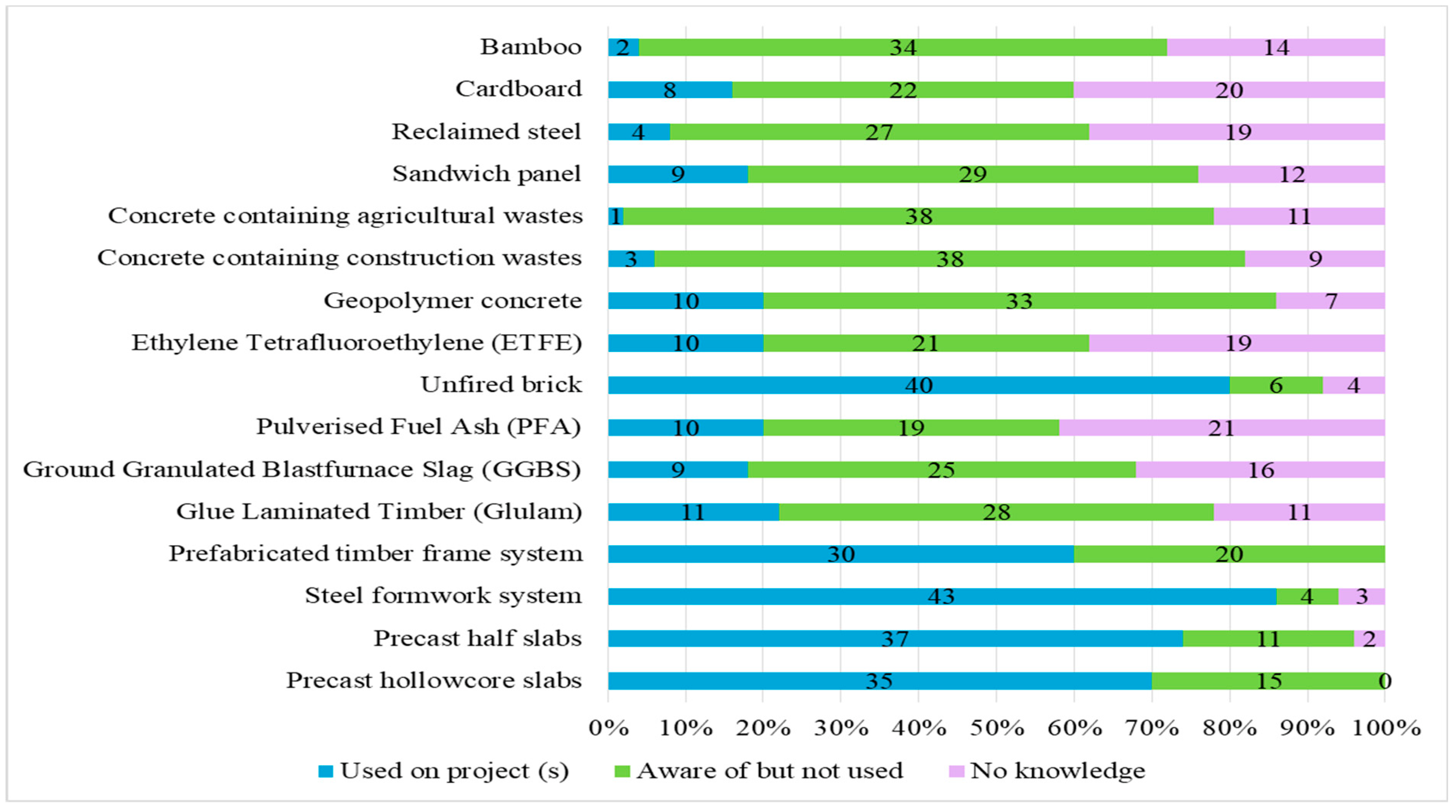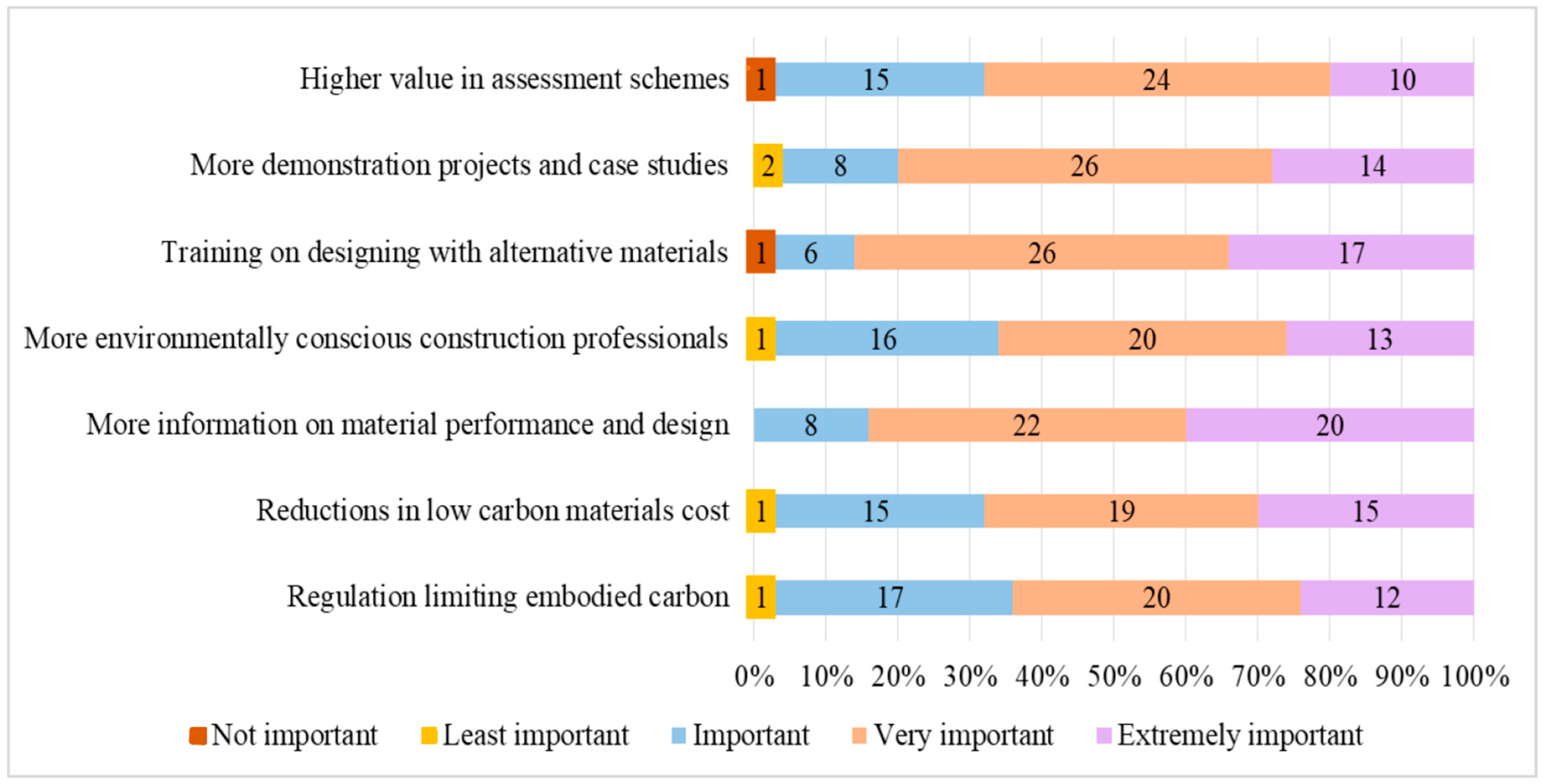Selection of Low-Carbon Building Materials in Construction Projects: Construction Professionals’ Perspectives
Abstract
:1. Introduction
2. Literature Review
2.1. Existing Studies
2.2. Barriers to the Adoption of Alternative Materials in the Construction Industry
3. Low-Carbon Building Materials
3.1. Precast Hollow Core Slabs
3.2. Precast Half Slabs
3.3. Steel Framework System
3.4. Prefabricated Timber Frame System
3.5. Glued Laminated Timber
3.6. Ground Granulated Blastfurnace Slag
3.7. Pulverized Fuel Ash
3.8. Unfired Brick
3.9. Ethylene Tetrafluoroethylene
3.10. Geopolymer Concrete
4. Research Methodology
4.1. Design of Study and Respondents
4.2. Study Instrument
4.3. Data Analysis
5. Results and Discussion
5.1. Respondents’ Backgrounds
5.2. Selection of Construction Materials
5.3. Experience in Using Alternative Materials
5.4. Barriers to Selection of Alternative Materials
5.5. Summary of Findings
- (a)
- Influence of construction professionals
- (b)
- Knowledge of alternative materials
- (c)
- Frequency of use of materials
- (d)
- Experience in using material
- (e)
- Current factors encouraging the use of alternative materials
- (f)
- Future factors encouraging the use of alternative materials.
- (g)
- Barriers to Material Selection
6. Conclusions
Supplementary Materials
Author Contributions
Funding
Institutional Review Board Statement
Informed Consent Statement
Data Availability Statement
Conflicts of Interest
References
- Ara, R.; Sohag, K.; Mastura, S.; Abdullah, S.; Jaafar, M. CO2 emissions, energy consumption, economic and population growth in Malaysia. Renew. Sustain. Energy Rev. 2015, 41, 594–601. [Google Scholar]
- Ahmed Ali, K.; Ahmad, M.I.; Yusup, Y. Issues, impacts, and mitigations of carbon dioxide emissions in the building sector. Sustainability 2020, 12, 7427. [Google Scholar] [CrossRef]
- Mahidin, M.U. Current Population Estimates, Malaysia, 2016–2017; Department of Statistics Malaysia: Kuala Lumpur, Malaysia, 2017; pp. 1–4.
- Cabeza, L.F.; Rincón, L.; Vilariño, V.; Pérez, G.; Castell, A. Life Cycle Assessment (LCA) and Life Cycle Energy Analysis (LCEA) of buildings and the building sector: A review. Renew. Sustain. Energy Rev. 2014, 29, 394–416. [Google Scholar] [CrossRef]
- Venkatarama Reddy, B.V. Sustainable materials for low carbon buildings. Int. J. Low Carbon Technol. 2009, 4, 175–181. [Google Scholar] [CrossRef] [Green Version]
- Omar, W.M.S. A hybrid life cycle assessment of embodied energy and carbon emissions from conventional and industrialised building systems in Malaysia. Energy Build. 2018, 167, 253–268. [Google Scholar] [CrossRef]
- Zhang, N.; Yu, K.; Chen, Z. How does urbanization affect carbon dioxide emissions? A cross-country panel data analysis. Energy Policy 2017, 10, 678–687. [Google Scholar]
- Arup & World Business Council for Sustainable Development (WBCSD). Material Choice for Green Buildings. 2012. Available online: https://docs.wbcsd.org/2012/01/WBCSD_Material_choice_for_green_buildings.pdf (accessed on 25 October 2021).
- Watson, N.; Walker, P.; Wylie, A.; Way, C. Evaluating the barriers to entry for non-conventional building materials. In Proceedings of the International Association for Bridge and Structural Engineering (IABSE) 2012 Spring Conference on Global Thinking in Structural Engineering: Recent Achievements, Sharm El Sheikh, Egypt, 7–9 May 2012. [Google Scholar]
- Saranya, P.; Nagarajan, P.; Shashikala, A.P. Eco-friendly GBBS Concrete: A state-of-the-art-review. IOP Conf. Ser. Mater. Sci. Eng. 2018, 330, 012057. [Google Scholar] [CrossRef] [Green Version]
- Sutton, A.; Black, D.; Walker, P. Unfired clay masonry: An introduction to low-impact building materials. Inf. Pap. BRE Publ. 2011, 15, 1–6. [Google Scholar]
- Lamnatou, C.; Moreno, A.; Chemisana, D.; Reitsma, F.; Clariá, F. Ethylene tetrafluoroethylene (ETFE) material: Critical issues and applications with emphasis on buildings. Renew. Sustain. Energy Rev. 2018, 82, 2186–2201. [Google Scholar] [CrossRef] [Green Version]
- Neupane, K. High-strength geopolymer concrete: Properties, advantages and challenges. Adv. Mater. 2019, 7, 15. [Google Scholar] [CrossRef]
- Construction Industry Development Board (CIDB). Contractor Registration Requirements and Procedures Handbook: Requirements and Procedures for Contractor Registration with the Construction Industry Development Board. 2016. Available online: https://pdfcoffee.com/cidb-catogeries-english-translation-14112016-pdf-free.html (accessed on 20 December 2021).
- Tweney, R.D. History of analysis of variance. In Wiley StatsRef: Statistics Reference Online; Bowling Green State University: Pauling Green, OH, USA, 2014; pp. 1–4. [Google Scholar]
- Hartmann, A. The role of organizational culture in motivating innovative behaviour in construction firms. Constr. Innov. 2006, 6, 159–172. [Google Scholar] [CrossRef]
- Oluwole Akadiri, P. Investigating factors influencing building materials selection in Nigerian construction industry. Am. J. Civ. Eng. Archit. 2018, 6, 154–157. [Google Scholar] [CrossRef] [Green Version]
- Scofield, T.L. Math 143-ANOVA. 2018. Available online: https://sites.calvin.edu/scofield/courses/m143/materials/handouts/anova1And2.pdf (accessed on 27 December 2021).
- Ho, C.S.; Adeyemi, A. Low Carbon Cities: The way forward in real estate development in Malaysia. Int. J. Real Estate Stud. 2013, 8, 50–59. [Google Scholar]
- Ogunkah, I.; Yang, J. Investigating factors affecting material selection: The impacts on green vernacular building materials in the design-decision making process. Buildings 2012, 2, 1–32. [Google Scholar] [CrossRef] [Green Version]
- Giesekam, J.; Barrett, J.R.; Taylor, P. Construction sector views on low carbon building materials. Build. Res. Inf. 2016, 44, 423–444. [Google Scholar] [CrossRef]
- Pedgley, O. Influence of stakeholders on industrial design materials and manufacturing selection. Int. J. Des. 2009, 3, 1–15. [Google Scholar]
- Zhang, S.; Xiang, X.; Ma, Z.; Ma, M.; Zou, C. Carbon neutral roadmap of commercial building operations by mid-century: Lessons from China. Buildings 2021, 11, 510. [Google Scholar] [CrossRef]
- Aghdam, K.A.; Rad, A.F.; Shakeri, H.; Sardroud, J.M. Approaching green buildings using eco-efficient construction materials: A review of the state-of-the-art. J. Constr. Eng. Proj. Manag. 2018, 8, 1–23. [Google Scholar]




| Source of Variation | Sum of Squares (SS) | Degree of Freedom (df) | Mean Square (MS) | F |
|---|---|---|---|---|
| Between groups | SSB | k − 1 | SSB/(k–1) | MSSB/MSSW |
| Within groups | SSW | N − k | SSW/(N–k) | |
| Total | SST | N − 1 |
| Group | Count | Sum | Average | Variance |
|---|---|---|---|---|
| Architects | 10 | 49 | 4.9 | 2.3222 |
| Contractors | 20 | 120 | 6 | 3.1579 |
| Engineers | 20 | 120 | 6 | 4.2105 |
| Source of Variation | SS | df | MS | F | p-Value * | F Crit |
|---|---|---|---|---|---|---|
| Between groups | 9.68 | 2 | 4.84 | 1.4138 | 0.2534 | 3.1951 |
| Within groups | 160.9 | 47 | 3.4234 | |||
| Total | 170.58 | 49 |
| Groups | Count | Sum | Average | Variance |
|---|---|---|---|---|
| Civil/Structural engineer | 50 | 307 | 6.14 | 2.7351 |
| Sustainability consultant | 50 | 268 | 5.36 | 5.0514 |
| Main/Subcontractor | 50 | 241 | 4.82 | 4.5996 |
| Project manager | 50 | 377 | 7.54 | 2.7024 |
| Quantity surveyor | 50 | 243 | 4.86 | 3.2657 |
| Architect | 50 | 275 | 5.5 | 3.2347 |
| Planner | 50 | 331 | 6.62 | 4.8527 |
| Client | 50 | 380 | 7.6 | 3.9184 |
| Source of Variation | SS | df | MS | F | p-Value * | F Crit |
|---|---|---|---|---|---|---|
| Between groups | 433.15 | 7 | 61.8786 | 16.3053 | 7.38 × 10−19 | 2.0329 |
| Within groups | 1487.64 | 392 | 3.795 | |||
| Total | 1920.79 | 399 |
| Groups | Count | Sum | Average | Variance |
|---|---|---|---|---|
| Precast hollowcore slabs | 50 | 261 | 5.22 | 6.42 |
| Precast half slabs | 50 | 264 | 5.28 | 5.9608 |
| Steel formwork system | 50 | 287 | 5.74 | 4.9718 |
| Prefabricated timber frame system | 50 | 214 | 4.28 | 7.8384 |
| Glue laminated timber (Glulam) | 50 | 122 | 2.44 | 4.7412 |
| Ground granulated blastfurnace slag (GGBS) | 50 | 113 | 2.26 | 3.9922 |
| Pulverised fuel ash (PFA) | 50 | 123 | 2.46 | 4.5392 |
| Unfired brick | 50 | 268 | 5.36 | 5.3780 |
| Ethylene tetrafluoroethylene (ETFE) | 50 | 123 | 2.46 | 4.6616 |
| Geopolymer concrete | 50 | 131 | 2.62 | 5.0159 |
| Concrete containing construction wastes | 50 | 85 | 1.7 | 2.7857 |
| Concrete containing agricultural wastes | 50 | 83 | 1.66 | 2.1882 |
| Sandwich panel | 50 | 114 | 2.28 | 4.4506 |
| Reclaimed steel | 50 | 96 | 1.92 | 3.2180 |
| Cardboard | 50 | 102 | 2.04 | 4.9780 |
| Bamboo | 50 | 69 | 1.38 | 0.8118 |
| Source of Variation | SS | df | MS | F | p-Value * | F Crit |
|---|---|---|---|---|---|---|
| Between groups | 1753.5988 | 15 | 116.9066 | 25.9968 | 6.07 × 10−59 | 1.6792 |
| Within groups | 3525.62 | 784 | 4.4970 | |||
| Total | 5279.2188 | 799 |
| Group | Count | Sum | Average | Variance |
|---|---|---|---|---|
| Felt morally obliged to use low-carbon materials | 50 | 265 | 5.3 | 2.2959 |
| Earned points towards assessment scheme | 50 | 267 | 5.34 | 2.3922 |
| Architect, engineer or contractor required it | 50 | 325 | 6.5 | 2.0918 |
| Client required it | 50 | 353 | 7.06 | 2.0984 |
| Offered best structural performance | 50 | 284 | 5.68 | 2.0588 |
| Desirable aesthetics | 50 | 270 | 5.4 | 1.7551 |
| Fits with company ethos | 50 | 277 | 5.54 | 2.2535 |
| The materials are more economic | 50 | 316 | 6.32 | 2.4261 |
| Save time of construction progress | 50 | 341 | 6.82 | 1.9057 |
| Save operation cost of construction project | 50 | 337 | 6.74 | 2.6453 |
| Often looking for new innovation | 50 | 319 | 6.38 | 1.9547 |
| Improved health and safety during construction progress | 50 | 343 | 6.86 | 2.0820 |
| Regulatory requirement | 50 | 333 | 6.66 | 2.6780 |
| Source of Variation | SS | df | MS | F | p-Value * | F Crit |
|---|---|---|---|---|---|---|
| Between groups | 254.76 | 12 | 21.23 | 9.6373 | 2.24745 × 10−17 | 1.7674 |
| Within groups | 1403.24 | 637 | 2.2029 | |||
| Total | 1658 | 649 |
Publisher’s Note: MDPI stays neutral with regard to jurisdictional claims in published maps and institutional affiliations. |
© 2022 by the authors. Licensee MDPI, Basel, Switzerland. This article is an open access article distributed under the terms and conditions of the Creative Commons Attribution (CC BY) license (https://creativecommons.org/licenses/by/4.0/).
Share and Cite
Chan, M.; Masrom, M.A.N.; Yasin, S.S. Selection of Low-Carbon Building Materials in Construction Projects: Construction Professionals’ Perspectives. Buildings 2022, 12, 486. https://doi.org/10.3390/buildings12040486
Chan M, Masrom MAN, Yasin SS. Selection of Low-Carbon Building Materials in Construction Projects: Construction Professionals’ Perspectives. Buildings. 2022; 12(4):486. https://doi.org/10.3390/buildings12040486
Chicago/Turabian StyleChan, Melissa, Md. Asrul Nasid Masrom, and Suleiman Said Yasin. 2022. "Selection of Low-Carbon Building Materials in Construction Projects: Construction Professionals’ Perspectives" Buildings 12, no. 4: 486. https://doi.org/10.3390/buildings12040486
APA StyleChan, M., Masrom, M. A. N., & Yasin, S. S. (2022). Selection of Low-Carbon Building Materials in Construction Projects: Construction Professionals’ Perspectives. Buildings, 12(4), 486. https://doi.org/10.3390/buildings12040486






